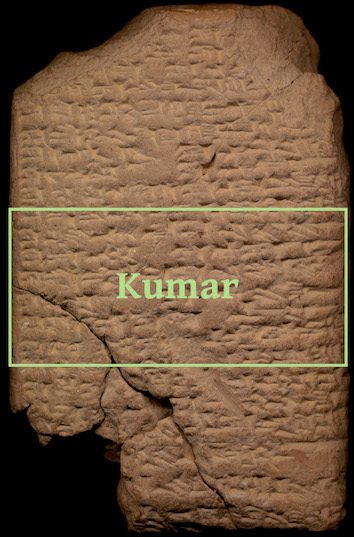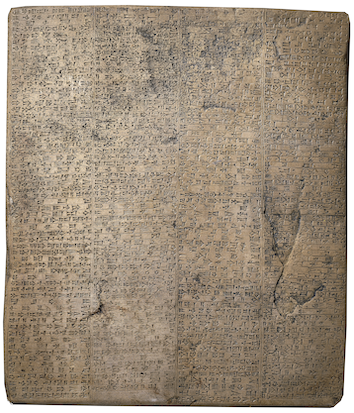Enamhe (temple of Adad at Babylon)

Enamhe was one of the seven religious buildings in the Kumar district of West Babylon, at least according to Tablet IV of the scholarly compendium Tintir = Babylon. That temple was dedicated to the storm-god Adad. This temple, which is first mentioned in cuneiform sources from the Old Babylonian Period (ca. 1900–1600 BC), was rebuilt by the industrious Neo-Babylonian king Nebuchadnezzar II (r. 604–562 BC).
Names and Spellings
This temple at Babylon went by the Sumerian ceremonial name Enamhe, which means "House of Plenty." One copy of Tablet IV of Tintir = Babylon refers to the temple as Enammah ("House of Loftiness").
- Written Forms: e₂-nam-he₂.
A bilingual Sumerian-Akkadian inscription of Nebuchadnezzar I (r. 1125–1104 BC), the fourth ruler of the Second Dynasty of Isin, mentions Enamhe together with Ekitušhegaltila ("House, Abode of Life-Giving Abundance"). The latter is either a byname of the former or the cella of Adad within it. Akkadian inscriptions of the Neo-Babylonian king Nebuchadnezzar II (r. 604–562 BC) allude to the name Ekitušhegaltila by referring to the storm-god as "the one who provides abundance in my land" (Akkadian mušaškin hegalli ina mātīya).
Known Builders
- Old Babylonian (ca. 1900–1600 BC)
- Sūmû-la-El (r. 1880–1845 BC)
- Hammu-rāpi (r. 1792–1750 BC)
- Neo-Babylonian (ca. 625–539 BC)
- Nebuchadnezzar II (r. 604–562 BC)
Building History

BM 129397, a large stone tablet that bears a long Akkadian inscription that is now commonly referred to as the "East India House Inscription." The description of Nebuchadnezzar's rebuilding of Edikukalama is recorded in lines iv 35–37. Image adapted from the British Museum Collection website. Credit: Trustees of the British Museum.
A temple of Adad at Babylon is first attested during the reign of Sūmû-la-El, the second ruler of the First Dynasty of Babylon. Year name date formulas for his seventh, eighth, and ninth regnal years (ca. 1873–1831 BC) mention the completion of that religious building. Hammu-rāpi, Sūmû-la-El's fourth successor, also rebuilt Enamhe. Work on that temple was carried out during his twenty-eighth year as king (ca. 1764 BC). Hammu-rāpi successors (Samsu-iluna, Abī-ešuh, and Ammī-ṣaduqa) attest to regular support of Enamhe during the First Dynasty of Babylon. This information comes from preserved year name date formulas.
Several Akkadian inscriptions of the Neo-Babylonian ruler Nebuchadnezzar II, including one written on a large stone tablet (the so-called "East India House Inscription") and a few written on rock faces in Lebanon, record that this ruler rebuilt Enamhe. None of the texts provide any details about that project.
Archaeological Remains
Enamhe has not yet been positively identified in the archaeological record.
Further Reading
- George, A.R. 1992. Babylonian Togographical Texts (Orientalia Lovaniensia Analecta 40), Leuven, pp. 329–330.
- George, A.R. 1993. House Most High. The Temples of Ancient Mesopotamia (Mesopotamian Civilizations 5), Winona Lake, pp. 129–130 no. 839.
- Pedersén, O. 2021. Babylon: The Great City, Münster, pp. 199–200.
Jamie Novotny & Joshua Meynell
Jamie Novotny & Joshua Meynell, 'Enamhe (temple of Adad at Babylon)', Babylonian Temples and Monumental Architecture online (BTMAo), The BTMAo Project, a sub-project of MOCCI, [http://oracc.org/btmao/Babylon/TemplesandZiggurat/Enamhe/]